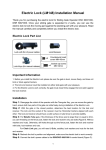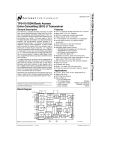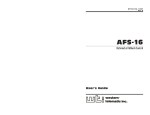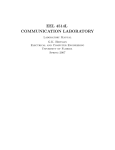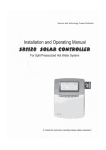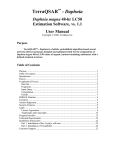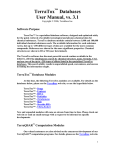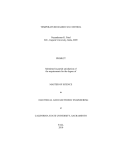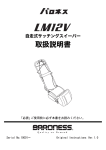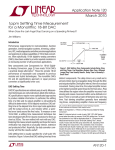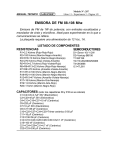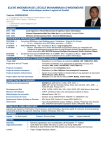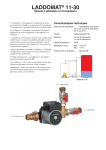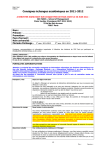Download A 20-Bit (1 ppm) Linear Slope
Transcript
National Semiconductor Application Note 260 January 1981 By combining an ‘‘inferior’’, 20 year old A/D conversion technique with a microprocessor, a developmental A/D converter achieves 1 part-per-million (20-bit) linearity. The absolute accuracy of the converter is primarily limited by the voltage reference available. The precision achieved by the unlikely combination of technologies surpasses conventional approaches by more than an order of magnitude. The approach used points the way towards a generation of ‘‘smart’’ converters, which would feature medium to high resolution (12 bits and above) with high accuracy over extended temperature range. The conversion technique employed, while slow speed, suits transducer based measurement systems which require high resolution over widely varying conditions of time and temperature. In addition, extensions of the basic converter have achieved 15-bit digitization of signal inputs of only 30 mV full-scale with no sacrifice in linearity or stability. This offers the prospect of an ‘‘instrumentation converter’’ which could interface directly with low level analog signals. One of the many A/D techniques utilized in the late 50’s and early 60’s was the single-slope-integrating converter. One form of this circuit compares a linear reference ramp to the unknown voltage input (see About Integrating Converters and Capacitors). When the ramp potential crosses the unknown input voltage a comparator changes state. The length of time between the start of the ramp and the comparator changing state is proportional to the input voltage. This length of time is measured digitally and presented as the converter output. The inherent strengths of this type of converter are simplicity and high linearity. Although singleslope-integrators were used in early A/Ds and voltmeters their dependence on an integrating capacitor for stability was considered an intolerable weakness. The advent of the dual-slope converter (see About Integrating Converters and Capacitors) solved the problem of integrating capacitor drift with time and temperature by error cancellation techniques. In a dual-slope converter the output represents the ratio of the time required to integrate the unknown voltage for a fixed time and then, using a reference voltage of opposing polarity, measures the amount of time required to get back to the original starting point (see About Integrating Converters and Capacitors). The technique eliminates capacitor drift as an error term. rent flow in the capacitor, including the magnitude, duration and direction of current flow (see About Integrating Converters and Capacitors). The nature of operation of dual-slope and related converters requires the instantaneous reversal of current in the integrating capacitor. This puts a substantial burden on the dielectric absorption characteristics of the capacitor. Although dual-slope and related techniques go far to cancel zero and full-scale drifts, residual non-linearity exists due to the effects of dielectric absorption. In addition to non-linearity, dielectric absorption can also cause the converter to give different outputs with a fixed input as the conversion rate is varied over any significant range. Various compensation arrangements are employed to partially offset these effects in present converters. What is really needed for high precision, however, is a conversion scheme which inherently acts to cancel the effects of dielectric absorption, while simultaneously correcting for zero and full-scale drifts. Limitations of Dual-Slope Converters The dual-slope converter, and variants on it, have been refined to a point where 16 and 17-bit resolution units are available. A primary detriment to linearity in these converters is a parasitic effect in capacitors called dielectric absorption. Dielectric absorption can be conceptualized as a slight hysteresis of response by the capacitor to charging and discharging. It is influenced by the recent history of cur- Overcoming Dual-Slope Limitations Figure 1 diagrams a converter which meets the requirement noted previously. In this arrangement a microprocessor is used to sequentially switch zero, full-scale reference and EX signals into one input of a comparator. The other comparator input is driven from the ramp output of an operational amplifier integrator. With no convert command applied to the microprocessor, the circuit is at quiescence. In this state the microprocessor sends a continuous, regularly spaced signal to the integrator reset switch. This results in a relatively fixed frequency, period and height ramp at the amplifier’s output. This relationship never changes, regardless of the converter’s operating state. In addition, the time between ramps is lengthy, resulting in an effective and repeatable reset for the capacitor. When a convert command is applied, the microprocessor switches the comparator input to the zero position, waits for the next available ramp and then measures the amount of time required for the ramp to cross zero volts. This information is stored in memory. The microprocessor then repeats this procedure for the fullscale reference and EX switch positions. With all this information, and the assumption that the integrator ramps are highly linear, the absolute value of EX is determined by the processor according to the following equation. [CEX b CZERO] c K mV EX e [CFULL-SCALE b CZERO] where C e count obtained and K e a constant, typically 107 After this equation is solved and the answer presented as the converter’s output, the conversion is complete and the microprocessor is ready to receive the next convert command. A 20-Bit (1 ppm) Linear Slope-Integrating A/D Converter A 20-Bit (1 ppm) Linear Slope-Integrating A/D Converter AN-260 C1995 National Semiconductor Corporation TL/H/5625 RRD-B30M115/Printed in U. S. A. TL/H/5625 – 1 FIGURE 1 The converter arrangement shares many of the characteristics of a dual-slope type and also provides some significant advantages. The key operating features are as follows: 1. It continuously corrects for zero and full-scale drift in all components in the A/D circuit, regardless of changes in time or temperature. The primary limitation on accuracy is the stability of the full-scale reference. The zero signal is derived through conventional high quality grounding technique. These features are similar to a dual-slope converter. 2. Because the integrating capacitor is always charged in a continuous pattern and in the same direction, the dielectric absorption induced error will be relatively small, constant, and will appear as an offset term. This offset term will be removed during the microprocessor’s calibration cycle. This feature is unique to this converter and is the key to high linearity. 3. The comparator always sees the ramp voltage approaching the trip point from the same direction and at the same slew rate, regardless of operating conditions. This helps maintain repeatability at the trip point in the face of noise and gain-bandwidth limitations in the comparator. 3. Unlike a dual-slope, this converter has no inherent noise rejection capability. The EX input signal is directly coupled to the comparator input with no filtering. This is a decided disadvantage because most ‘‘real world’’ signals require some smoothing. If a filter was placed at the input substantial time lag due to settling requirements would occur. This is unacceptable because the converter relies on short time intervals between multiplexer states to effectively cancel drift. The solution is to use the microprocessor to filter the signal digitally, using averaging techniques. Filling Out the Blocks The detailed schematic diagram of the prototype 20-bit linear A/D conveter is shown in Figure 2 . For clarity, the details of the INS8070 microprocessor and its associated logic are shown in block from. Note that the entire analog section of the converter is fully floating from the digital section to eliminate noise due to digital current spiking and clock noise. The analog and digital circuits communicate via optoisolators. The full-scale reference for the converter is provided by the LM199A-20-LM108A combination. This circuit, using the components specified, will typically deliver 0.25 ppm/§ C performance with drift of several ppm per year. The accuracy to which this reference can be maintained is the primary limitation on absolute accuracy in this converter. The output of this reference is fed to an FET-switched multiplexer which also receives the EX and zero signals. Because all these sources are at low impedance, and only one is switched on at a time, the leakage and ON resistances do not contribute significant error. The A4 combination provides a low bias current unity gain follower with greater than 1,000,00:1 (120 dB) of CMRR, preserving converter linearity. Drifts in this follower are not significant because they will be cancelled out by the microprocessor’s calibration cycle. The microprocessor’s digital commands to the FET switches are received by the 4N28 opto-isolators. The LM148 quad op-amp (A5) is used to generate the voltage swing necessary to control the FET switches. The discrete components at each amplifier output are used to generate one-way time delays to give the FET switches break-beforemake action. This prevents cross talk between the zero, fullscale reference and EX sources. 2 TL/H/5625 – 2 FIGURE 2 The requirement for a comparator with 1 ppm (1 LSB at 20 bits e 1 ppm) of trip point noise cannot be met by any standard device. At 10V full-scale this is only a 10 mV LSB. The 50 ms-10V ramp’s relatively slow slew rate means that the gain-bandwidth and noise characteristics of a standard differential input comparator will cause considerable uncertainty at the trip point. Also, as the common-mode voltage at which the ramp vs EX crossing occurs changes, the trip point of the comparator will shift, introducing overall non-linearity. Another FET is used to reset the integrator and is biased by a ‘‘brute-force’’ level shifting-edge speed-up network formed by the 2N2222-2N2369 pair. A 4N28 opto-isolator biases this network when it receives the reset signal from the INS8070 processor. A1, an LF356, has its ‘‘ a ’’ input biased at about negative 1V, ensuring that the ramp will start far enough below ground to determine a true zero signal. 3 These problems are addressed by the A2-A3 configuration, which forms a high precision comparator. A4’s negative output is resistively summed with the positive output of the A1 ramp at A2. A2 normally operates at a low gain due to the diode bounding in its feedback loop. When the currents produced by the ramp potential and A4’s output very nearly balance the potential at A2’s summing junction will go low enough so that A2 comes out of bound and operates at a gain determined by the 499k feedback resistor (about 100). A2 remains in this high-gain state as long as the ramp and A4 output caused currents are nearly equal. As the ramp continues in its positive going direction the current into A2’s summing junction will go to zero and then move positive until the A2 output bounds negative. The output of A2 drives A3, an LM311 comparator which is set up as a zero crossing detector. The components in the positive feedback path at A3 insure a sharp transition. Figure 3 shows the waveforms of operation. The ramp (a) is shown in highly expanded form. The A2 output (b) can be seen to come cleanly out of diode-bound just before the ramp balances A4’s output and then return to bound after the crossing occurs. Waveform (c) is A3’s output. The A2 pre-amplifier makes the A3 comparator’s job much easier in a number of ways. It amplifies the voltage difference of the two signals to be compared by a factor of 100. This knocks down the effect of A3’s input uncertainties. It also produces an apparent 100 fold increase in the ramp slew rate at the trip point. This means A3 spends that much less time with its inputs nearly balanced in an uncertain and noise sensitive condition. Finally, A2 presents the difference signal as a single ended zero crossing signal. This eliminates errors due to changing commonmode voltages that a differential comparator’s input would face. Such errors would manifest themselves as overall converter non-linearity. Converter Performance and Testing Figure 4 shows the convert at work. A complete conversion cycle is captured in the photograph. Waveform (a) is the integrator reset out of the INS8070. (b) is the ramp at A1’s output. Waveform (c) is the multiplexer output at A4, showing the zero, full-scale reference and EX states. For each state ample time is allowed before the ramp begins. The width output is shown in waveform (d). TL/H/5625 – 4 FIGURE 4 The converter was tested with the arrangement shown in Figure 5 . The Kelvin-Varley voltage divider, a primary standard type, has a guaranteed linearity of within 1 ppm. The LM11 op amp provides a low bias current, low drift follower to unload the Kelvin divider’s output impedance. Because the LM11 gives greater than 120 dB common-mode rejection, its voltage output should track the linearity of the Kelvin divider. To test this the LM11 was adjusted for offset null and a battery-powered mV meter connected between its inputs. 20-bit linear (1 ppm) transfer characteristics were verified by running the Kelvin divider through its range and noting less than 10 mV (1 LSB at 10V full-scale) shift under all conditions. Then, the converter reference was used to drive the Kelvin divider input and the LM11 output to the EX input of the A/D converter. TL/H/5625–3 FIGURE 3 The output of the A3 comparator feeds a 2N2369 transistor, which functions as a level shifter-gate. This transistor gates out that portion of the width output pulse which would be due to the length of the integrator reset pulse. The 2N2369, a low storage capacitance device, provides high speed, even in the relatively slow common emitter configuration. The HP-2602 high speed opto-coupler transmits the width information to the digital circuitry. TL/H/5625 – 5 FIGURE 5 4 bridge output for a given bridge drive level. In this manner, even if the bridge drive varies, the gain of the system remains calibrated by ratiometric error cancellation. The zero signal is derived by shorting both amplifier inputs to the common-mode voltage at the bridge output. This system has been built and has maintained 15-bit accuracy over a 75§ F temperature range. Prospective constructors of this converter are advised that construction technique is extremely critical. In order for the converter to operate properly, the greatest care must be taken in grounding, guarding and shielding techniques. Useful sources of information are listed in the References A typical output on the Hewlett-Packard 2644A CRT terminal display is shown in Figure 6 . For each convert command to the INS8070 the number of counts of zero, full-scale reference and EX are shown along with the final computed answer. Note that the final count is computed to one part in ten million and the last digit is insignificant. Note also that the 4 final counts are all within g 1 ppm . . . despite the fact that they were individually spaced almost 1 hour apart in a varying thermal environment. Linearity of the converter over a 10V range was verified at 10 points by varying the MSB of the Kelvin divider. Although the prototype converter takes 300 ms to complete a cycle, faster speed is attainable by increasing the 20 MHz clock rate. Perhaps more practically, higher conversion speeds at lower resolutions are easily attainable by simply shortening the ramp time. The converter output word length and conversion time may be varied over a wide dynamic range by juggling clock speed and ramp time. References 1. ‘‘Grounding and Shielding Techniques in Instrumentation’’, R. Morrison; Wiley Interscience. 2. ‘‘Designing Sensitive Circuits? Don’t Take Grounds for Granted!’’, A. P. Brokaw; EDN, October 5, 1975. 3. ‘‘Input Connection Practices for Differential Amplifiers’’, J. H. Hueckel; Neff Inst. Corp. 4. ‘‘Prevent Low Level Amplifier Problems’’, J. Williams; Electronic Design, February 15, 1975. 5. ‘‘Signal Conditioning’’, Gould Inc., Brush Insts. Div., Cleveland, Ohio. 6. ‘‘On Computing Errors of an Integrator’’, T. Miura, et. al; Proc. 2nd ALCA Conf. Strasbourg, France. 1958. Presses Academiques Europeennes, Brussels. 7. ‘‘Comparator I.C. Forms 10-Bit A/D Converter’’, J. Williams: Electronics, April 17, 1975. 8. ‘‘Low Cost, Linear A/D Conversion Uses Single-Slope Techniques’’, J. Williams: EDN, August 5, 1978. 9. Component Research Corp.ÐCatalog JB. 10. ‘‘The Secret Life of Capacitors’’, ECD Corp., Cambridge, Massachusetts. 11. ‘‘An Analysis of Errors in Single Slope Integrators’’, R. A. Eckhardt; S. B. Thesis, M.I.T., 1974. 12. ‘‘Characterization, Measurement and Compensation of Errors in Capacitors . . . a compendium of study, hacks, some good stuff and a few pearls’’, J. Williams; Massachusetts Institute of Technology, Cambridge, Massachusetts, 1975. 13. ‘‘Operating and Service Manual Ð HP3440 D.V.M.’’; Hewlett-Packard Co., 1961. TL/H/5625 – 6 FIGURE 6 Although demonstrating a 20-bit converter is useful, there are other applications which do not require this degree of precision. The basic technique is readily adaptable to the practical solution of common transducer and other low-level interface problems. Figure 7 shows the block diagram of the converter used to generate a 15-bit output directly from a 30 mV full-scale input. In this application the converter input is a differential input amplifier with a nominal gain of 300. Note that the amplifier’s offset and gain drift will be cancelled by the microprocessor’s calibration loop. The EX signal is the output of the transducer bridge. The full-scale reference signal is derived by measuring across the middle resistor of a string which has the same voltage across it as the nominal FIGURE 7 5 TL/H/5625 – 7 Both of these converters are dependent to varying degrees on capacitor characteristics. The single-slope type requires stability in the capacitor over time and temperature while the dual-slope gets around this limitation. The effects of a phenomenon in capacitors called dielectric absorption, however, have direct impact on dual-slope performance. Dielectric absorption is due to the capacitor dielectric’s unwillingness to accept or give up charge instantaneously. It is commonly and simply modeled as a parasitic series RC (Figure C ) across the terminals of the main capacitor. If a charged capacitor is discharged, even through a dead short, some degree of time will be required to remove all of the charge in the parasitic capacitance due to the parasitic series resistance. Conversely, some amount of charge will be absorbed by the parasitic capacitor after a charging of the main capacitor has ceased unless the charge source is maintained for many parasitic RC time constants. Various dielectrics offer differing performance with respect to dielectric absorption. Teflon, polystyrene and polypropylene are quite good, while paper, mylar and glass are relatively poor. Electrolytics are by far the worst offenders. Anyone who has received a shock after discharging a high voltage electrolytic in a television set has experienced the effect of dielectric absorption. About Integrating Converters and Capacitors The simplest form of integrating converter is the singleslope type (Figure A ). In the single-slope unit shown, a linear reference ramp is compared against the unknown input, EX. When the switch across the integrator capacitor is opened, the ramp begins. The time interval between the opening of the integrator reset switch and the comparator changing state (when ERAMP e EX) is directly proportional to the value of EX. This converter requires that the integrating capacitor and the clock used to measure the time interval be stable over time and temperature . . . a significant drawback under normal circumstances. The dual-slope integrator (Figure B ) overcomes these problems by effectively normalizing the capacitor value and clock rate each time a conversion is made. It does this by integrating the EX input for a pre-determined time. Then, the voltage reference is switched to the integrator input which proceeds to integrate in a negative going direction from the EX slope. The length of time the reference slope requires to get back to zero is proportionate to the EX signal value. These slopes are both established with the same integrating capacitor and measured with the same clock, so both parameters need only be stable over one conversion cycle. TL/H/5625 – 9 FIGURE A TL/H/5625 – 8 FIGURE C FIGURE B 6 7 A 20-Bit (1 ppm) Linear Slope-Integrating A/D Converter LIFE SUPPORT POLICY NATIONAL’S PRODUCTS ARE NOT AUTHORIZED FOR USE AS CRITICAL COMPONENTS IN LIFE SUPPORT DEVICES OR SYSTEMS WITHOUT THE EXPRESS WRITTEN APPROVAL OF THE PRESIDENT OF NATIONAL SEMICONDUCTOR CORPORATION. As used herein: AN-260 1. Life support devices or systems are devices or systems which, (a) are intended for surgical implant into the body, or (b) support or sustain life, and whose failure to perform, when properly used in accordance with instructions for use provided in the labeling, can be reasonably expected to result in a significant injury to the user. National Semiconductor Corporation 1111 West Bardin Road Arlington, TX 76017 Tel: 1(800) 272-9959 Fax: 1(800) 737-7018 2. A critical component is any component of a life support device or system whose failure to perform can be reasonably expected to cause the failure of the life support device or system, or to affect its safety or effectiveness. National Semiconductor Europe Fax: (a49) 0-180-530 85 86 Email: cnjwge @ tevm2.nsc.com Deutsch Tel: (a49) 0-180-530 85 85 English Tel: (a49) 0-180-532 78 32 Fran3ais Tel: (a49) 0-180-532 93 58 Italiano Tel: (a49) 0-180-534 16 80 National Semiconductor Hong Kong Ltd. 13th Floor, Straight Block, Ocean Centre, 5 Canton Rd. Tsimshatsui, Kowloon Hong Kong Tel: (852) 2737-1600 Fax: (852) 2736-9960 National Semiconductor Japan Ltd. Tel: 81-043-299-2309 Fax: 81-043-299-2408 National does not assume any responsibility for use of any circuitry described, no circuit patent licenses are implied and National reserves the right at any time without notice to change said circuitry and specifications.








